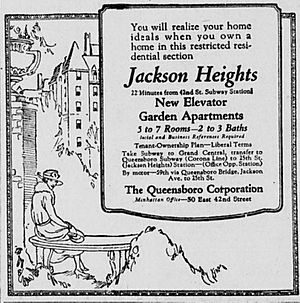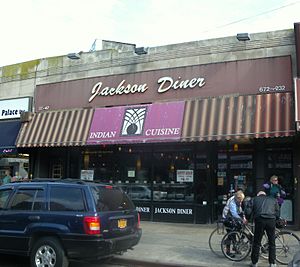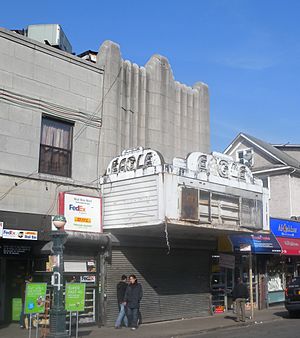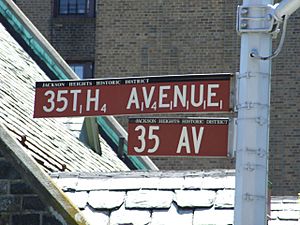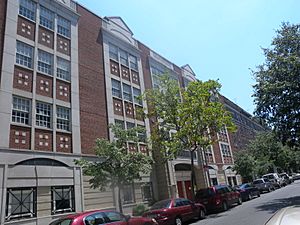Jackson Heights, Queens facts for kids
Quick facts for kids
Jackson Heights
|
|
|---|---|
|
Neighborhood of Queens
|
|
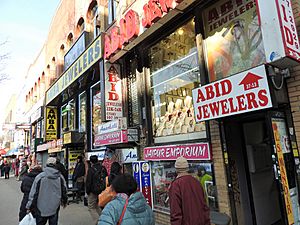
Little India on 74th Street in Jackson Heights
|
|
| Country | United States |
| State | New York |
| City | New York City |
| Borough | Queens |
| Community District | Queens 3 |
| Population
(2010)
|
|
| • Total | 108,152 |
| Ethnicity | |
| • Hispanic | 56.5% |
| • Asian | 22.0 |
| • White | 17.2 |
| • Black | 2.0 |
| • Other/Multiracial | 2.3 |
| Time zone | UTC−5 (EST) |
| • Summer (DST) | UTC−4 (EDT) |
| ZIP Code |
11370, 11372
|
| Area codes | 718, 347, 929, and 917 |
Jackson Heights is a neighborhood in the northwestern portion of the borough of Queens in New York City. Jackson Heights is neighbored by North Corona to the east, Elmhurst to the south, Woodside to the west, northern Astoria (Ditmars-Steinway) to the northwest, and East Elmhurst to the northeast. Jackson Heights has an ethnically diverse community, with half the population having been foreign-born since the 2000s. According to the 2010 United States Census, the neighborhood has a population of 108,152.
The site of Jackson Heights was a vast marsh named Trains Meadow until 1909 when Edward A. MacDougall's Queensboro Corporation bought 325 acres (132 ha) of undeveloped land and farms.
The Queensboro Corporation named the land Jackson Heights after John C. Jackson, a descendant of one of the original Queens families and a respected Queens entrepreneur. Further development arose through the development of transit, and "garden apartments" and "garden homes" soon became prevalent in Jackson Heights. During the 1960s, Jackson Heights' white middle-class families began moving to the suburbs, and non-white residents began moving in.
Jackson Heights retains much of its residential character in the modern day. It also has numerous commercial establishments clustered around 37th Avenue, as well as along several side streets served by subway stations. Much of the neighborhood is part of a national historic district called the Jackson Heights Historic District, which was listed on the National Register of Historic Places in 1999. Part of the neighborhood was placed on a New York City historic district of the same name in 1993.
Jackson Heights is located in Queens Community District 3 and its ZIP Codes are 11370 and 11372. It is patrolled by the New York City Police Department's 115th Precinct. Politically, Jackson Heights is represented by the New York City Council's 21st and 25th districts.
History
Early history
The Jackson Heights name comes from Jackson Avenue, the former name for Northern Boulevard, a major thoroughfare that bisects the neighborhood. John C. Jackson built the road across what is now Jackson Heights in 1859. The Jackson Avenue name is retained by this major road in a short stretch between Queens Plaza and Queens–Midtown Tunnel in Long Island City. The place was not particularly high, but the name "heights" showed that the place was originally meant to be exclusive. Until 1916, the area was called "Trains Meadow", but contrary to the name, there were very few trains in the area. It is suspected that it was corrupted from "drain".
The first land purchase of 128 acres (52 ha) was completed in 1910, and Edward A. MacDougall's Queensboro Corporation had bought about 325 acres (132 ha) by 1914. At first, the area could most easily be reached via a ferry from Manhattan or the Brooklyn bridges, but the Queensboro Bridge opened in 1909, followed by the elevated IRT Flushing Line—the present-day 7 train, just 20 minutes from Manhattan—came in 1917, and Fifth Avenue Coach Company double-decker coaches came in 1922.
Development
Jackson Heights was a planned development laid out by the Queensboro Corporation beginning in about 1916, and residents came after the arrival of the Flushing Line into Jackson Heights in 1917. The community was initially planned as a place for middle- to upper-middle income workers from Manhattan to raise their families. The Queensboro Corporation coined the name "garden apartment" to convey the concept of apartments surrounded by a green environment. The apartments, built around private parks during this time, contributed to Jackson Heights' being the first garden city community built in the United States, as part of the international garden city movement at the turn of the 20th century. Most of the buildings in Jackson Heights are the Queensboro Corporation apartments, built within a few blocks of the Flushing Line, which are typically five or six stories tall and are located between Northern Boulevard and 37th Avenue as part of that planned community. Targeted toward the middle class, the Queensboro Corporation-based the new apartments off of similar ones in Berlin. These new apartments were to share garden spaces, have ornate exteriors and features such as fireplaces, parquet floors, sun rooms, and built-in bathtubs with showers; and be cooperatively owned. In addition, the corporation divided the land into blocks and building lots, as well as installed streets, sidewalks, and power, water, and sewage lines. Although land for churches was provided, the apartments themselves were limited to white Anglo-Saxon Protestants, while excluding Jews, Blacks, and perhaps Greeks and Italians.
The Laurel apartment building on 82nd Street at Northern Boulevard was the first of the Queensboro Corporation buildings in Jackson Heights, completed in 1914 with a small courtyard. The Greystones on either side of 80th Street between 37th and 35th Avenues were completed in 1918 with a design by architect George H. Wells. There was leftover unused space, which was converted to parks, gardens, and recreational areas, including a golf course; much of this leftover space, including the golf course, no longer exists. This was followed by the 1919 construction of the Andrew J. Thomas-designed Linden Court, a 10-building complex between 84th Street, 85th Streets, 37th Avenue, and Roosevelt Avenue. The two sets of 5 buildings each, separated by a gated garden with linden trees and two pathways, included parking spaces with single-story garages accessed via narrow driveways, the first Jackson Heights development to do so; gaps at regular intervals in the perimeter wall; a layout that provided light and ventilation to the apartments, as well as fostered a sense of belonging to a community; the area's first co-op; and now-prevalent private gardens surrounded by the building blocks.
The Hampton Gardens, the Château, and the Towers followed in the 1920s. The Château and the Towers, both co-ops on 34th Avenue, had large, airy apartments and were served by elevators. The elegant Château cooperative apartment complex, with twelve buildings surrounding a shared garden, was built in the French Renaissance style and have slate mansard roofs pierced by dormer windows, and diaperwork brick walls. At first purely decorative, the shared gardens in later developments included paved spaces where people could meet or sit. The Queensboro Corporation started the Ivy Court, Cedar Court, and Spanish Gardens projects, all designed by Thomas, in 1924.
The Queensboro Corporation advertised their apartments from 1922 on. On August 28, 1922, the Queensboro Corporation paid $50 to the WEAF radio station to broadcast a ten-minute sales pitch for apartments in Jackson Heights, in what may have been the first "infomercial", opening with a few words about Nathaniel Hawthorne before promoting the corporation's Nathaniel Hawthorne apartments. The ad wanted viewers to:
seek the recreation and the daily comfort of the home removed from the congested part of the city, right at the boundaries of God's great outdoors, and within a few minutes by subway from the business section of Manhattan ... The cry of the heart is for more living room, more chance to unfold, more opportunity to get near Mother Earth, to play, to romp, to plant and to dig ... Let me enjoin upon you as you value your health and your hopes and your home happiness, get away from the solid masses of brick ... where your children grow up starved for a run over a patch of grass and the sight of a tree...
Built in 1928, the English Gables line 82nd Street, the main shopping area of Jackson Heights' Hispanic community. There are two developments, called English Gables I and II; they were meant to provide a gateway to the neighborhood for commercial traffic and for passengers from the 82nd Street – Jackson Heights station. A year later, the Robert Morris Apartments, on 37th Avenue between 79th and 80th Streets, were constructed. Named after Robert Morris, a signer of the United States Declaration of Independence, the apartments have ample green spaces, original high ceilings, and fireplaces, and are relatively expensive.
Decline and ethnic change
Until the Great Depression, these apartments were only half-filled due to the paucity of residents who could pay; after the Depression, the apartments became more affordable. During the Depression, two new buildings were built: Ravenna Court on 37th Avenue between 80th and 81st Streets, built in 1929; and Georgian Court three blocks east, between 83rd and 84th Streets, built in 1930. The Queensboro Corporation began to build on land that until then had been kept open for community use, including the tennis courts, community garden, and the former golf course—located between 76th and 78th Streets and 34th and 37th Avenues—all of which were built upon during the 1940s and 1950s. The corporation also began erecting traditional six-story apartment buildings. Dunolly Gardens, the last garden apartment complex that Thomas built, was an exception, a modernistic building completed in 1939. The corner windows, considered very innovative in the 1930s, gave the apartments a more spacious feeling. After the 1940s, Jackson Heights's real estate was diversified, and more apartment buildings and cooperatives were built with elevators; some new transportation infrastructure were also built.
Primarily during the 1930s, Holmes Airport operated on 220 acres (0.89 km2) adjacent to the community, and later, its land became veterans' housing and the Bulova watch factory site.
By 1930, about 44,500 people lived in Jackson heights, an increase from 3,800 residents in 1910. The community was close-knit. Gay people from Broadway theaters started to move into the area. However, Jewish and black people were still excluded until Jews were allowed to move in by the 1940s and blacks by 1968. Beginning in the 1960s, an influx of newly immigrated residents came into Jackson Heights, at the same time that existing residents were leaving for suburbs due to white flight. Hispanic immigrants moved in by the 1970s. By then, white residents who remained in the neighborhood wished to eliminate the stigma of Jackson Heights being an ethnically diverse neighborhood, often defining its border as Roosevelt Avenue, because crime had started to increase in the area. By the mid-1970s, South American organized crime groups in Jackson Heights, often peddling drugs, gained national attention. A 1978 article in New York Magazine stated that 27 people were killed in Jackson Heights in the three years preceding.
Historic designation
|
Jackson Heights Historic District
|
|
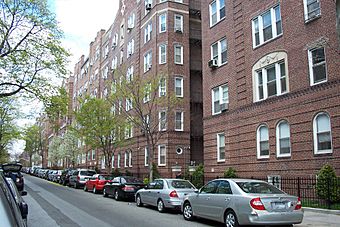
Residential street in Jackson Heights
|
|
| Location | Bounded by Roosevelt Ave., Broadway, Leverich St., 70 St., Northern Blvd., and Junction Blvd., Queens, NYC |
|---|---|
| Area | 300 acres (120 ha) |
| Architectural style | Late 19th and 20th Century Revivals |
| NRHP reference No. | 99000059 |
| Added to NRHP | January 27, 1999 |
Most of the original neighborhood, comprising the garden city apartment buildings, was made a National Register Historic District and a New York State Historic Register District. The Jackson Heights New York State and National Register Districts range from 93rd Street through 69th Street between Northern Boulevard and Roosevelt Avenue. Some property fronting on Northern Boulevard and Roosevelt Avenue, as well as some "cut-outs", are not inside the Register Districts. The national historic district called the Jackson Heights Historic District, includes 2,203 contributing buildings, 19 contributing sites, and three contributing objects. Among the landmarked buildings, over 200 original Queensboro Corporation apartment buildings still exist in Jackson Heights. It was listed on the National Register of Historic Places in 1999.
About half of the neighborhood—a rectangle stretching roughly from 76th Street to 88th Street and from Roosevelt Avenue almost up to Northern Boulevard—was designated as a New York City Historic District by the New York City Landmarks Preservation Commission on October 19, 1993. It comprises large apartment buildings with private communal gardens, as well as many groupings of private homes and many stores on the streets surrounding Roosevelt Avenue. Unlike the State and National Districts, the local designation comes with aesthetic protections.
In addition to the Jackson Heights Historic District, the Lent Homestead and Cemetery and United States Post Office are listed on the National Register of Historic Places.
Demographics
Based on data from the 2010 United States Census, the population of Jackson Heights was 108,152, a decrease of 5,175 (4.6%) from the 113,327 counted in 2000. Covering an area of 1,101.36 acres (445.70 ha), the neighborhood had a population density of 98.2 inhabitants per acre (62,800/sq mi; 24,300/km2). The racial makeup of the neighborhood was 17.2% (18,567) White, 2.0% (2,210) African American, 0.1% (145) Native American, 22.0% (23,781) Asian, 0.0% (9) Pacific Islander, 0.5% (583) from other races, and 1.6% (1,736) from two or more races. Hispanic or Latino of any race were 56.5% (61,121) of the population.
The entirety of Queens Community District 3, which comprises Jackson Heights as well as East Elmhurst and North Corona, had 179,844 inhabitants as of NYC Health's 2018 Community Health Profile, with an average life expectancy of 84.7 years. This is higher than the median life expectancy of 81.2 for all New York City neighborhoods. Most inhabitants are middle-aged adults and youth: 22% are between the ages of 0–17, 32% between 25 and 44, and 24% between 45 and 64. The ratio of college-aged and elderly residents was lower, at 9% and 12% respectively.
As of 2017, the median household income in Community Board 3 was $56,601. In 2018, an estimated 25% of Jackson Heights residents lived in poverty, compared to 19% in all of Queens and 20% in all of New York City. One in fourteen residents (7%) were unemployed, compared to 8% in Queens and 9% in New York City. Rent burden, or the percentage of residents who have difficulty paying their rent, is 59% in Jackson Heights, slightly higher than the boroughwide and citywide rates of 53% and 51% respectively. Based on this calculation, as of 2018[update], Jackson Heights is considered to be high-income relative to the rest of the city and not gentrifying.
However, in 2017, nearly 11% of households in Jackson Heights were severely overcrowded—defined as households in which there are more than 1.5 household members for each room (excluding bathrooms) in the unit—making it the second most overcrowded neighborhood in the city, behind only Elmhurst to the south.
The 2020 census data from New York City Department of City Planning showed that there were 54,300 Hispanic residents, 27,600 Asian residents, there were between 10,000 to 19,999 White residents and less than 5000 Black residents.
Transportation
Public transportation

The following New York City Subway stations serve Jackson Heights:
- Jackson Heights–Roosevelt Avenue/74th Street (7, E, F <F>, M, and R trains)
- 82nd Street–Jackson Heights (7 train)
- 90th Street–Elmhurst Avenue (7 train)
The following MTA Regional Bus Operations bus routes serve Jackson Heights:
- Q32: to Pennsylvania Station in Midtown Manhattan via Roosevelt Avenue and 81st/82nd Streets
- Q33: to East Elmhurst via 82nd/83rd Streets
- Q47: to LaGuardia Marine Air Terminal or Glendale via 73rd/74th Streets
- Q49: to East Elmhurst via 35th Avenue and 89th/90th/92nd Streets
- Q53 SBS: to 61st Street–Woodside (7 <7> trains)/Woodside LIRR or Rockaway Park–Beach 116th Street (A S trains) via Roosevelt Avenue and Broadway
- Q66: to Queensboro Plaza (7 <7>, N, and W trains) or Flushing–Main Street (7 <7> trains) via Northern Boulevard
- Q70 SBS: to 61st Street–Woodside (7 <7> trains)/Woodside LIRR or LaGuardia Airport Terminals B/C/D via Roosevelt Avenue, Broadway, and Brooklyn-Queens Expressway
- Q72: to 63rd Drive–Rego Park (M and R train) or LaGuardia Airport Terminals B/C/D via Junction Boulevard
The Jackson Heights–Roosevelt Avenue/74th Street station is a transportation hub where the subway's 7, E, F <F>, M, and R trains and the Q32, Q33, Q47, Q49. Q53 SBS and Q70 SBS buses converge. The MTA spent over $100 million on renovations to the Jackson Heights bus terminal, which were completed in 2005. It includes one of the first green buildings in the MTA system, the Victor A. Moore Bus Terminal, which is partially powered by solar panels built into the roof. These are located along the length of the sheds above the Flushing Line platforms. The terminal, as is the Victor Moore Arcade (which it replaced), is named after Jackson Heights resident Victor Moore, a Broadway and film actor from the era of silent film to the 1950s.
Roads
Interstate 278 (Brooklyn Queens Expressway), New York State Route 25A (Northern Boulevard), and the Grand Central Parkway are major roads in the area. LaGuardia Airport, in neighboring East Elmhurst, is nearby.
Eleven percent of roads in Jackson Heights have bike lanes, similar to the rate in the city overall. These lanes, part of the city's bikeway system, exist on 34th Avenue, as well as on 74th and 75th streets between 34th Avenue and 37th Road. There is also a short one-block bike lane connector on 37th Road between 74th and 75th streets.
Land use, boundaries, and streets
Jackson Heights, the original portion of which is only about 350 acres (140 ha), is bounded by Astoria Boulevard, Grand Central Parkway, or Northern Boulevard to the north, the Brooklyn-Queens Expressway to the west, Roosevelt Avenue to the south, and Junction Boulevard or 90th Street to the east.
East Elmhurst, the area immediately to the north that extends from Northern Boulevard to the Grand Central Parkway and between 81st and 111th Streets, is sometimes regarded as a northward extension of the neighborhood; however, it was not part of the original planned development, built in 1916. In addition, a section between Hazen and 81st Streets, and between 19th Avenue and Grand Central Parkway, overlaps with Astoria; it is sometimes called Ditmars or Steinway.
The historic section of Jackson Heights is the more affluent part of the neighborhood. Most housing units in Jackson Heights are apartments in multi-unit buildings, many of which are five or six stories. Many of these buildings are co-ops, some are rentals, and a few are condominiums. There are also a number of one- to three-family houses, most of which are attached row houses. The original Queensboro Corporation apartments were designed in the Colonial Revival and neo-Tudor styles. There are many private parks—historically called "gardens" by the residents—within walking distance of each other, tucked into the mid-blocks between the Queensboro Corporation apartments, mostly hidden from view by the buildings surrounding them. Unless given an invitation, entry is restricted to those who own a co-op around its perimeter. The basis for the private ownership of the parks of Jackson Heights is derived from its founding principle as a privately owned neighborhood built largely under the oversight of one person.
A section of 90th Street between 30th Avenue and Northern Boulevard was privately developed, separate from the Queensboro Corporation. The structures on that stretch of 90th Street are mostly Tudor buildings.
The main retail thoroughfare is 37th Avenue from 72nd Street to Junction Boulevard, with more retail on 73rd, 74th, and 82nd Streets between 37th and Roosevelt Avenues. Stores and restaurants on and near 74th Street tend to cater to the large South Asian population in the neighborhood, with sari and jewelry stores, Indian and Bengali music and movie retailers and many restaurants. 37th Avenue contains a wide mix of retailers, including many grocery stores, and 82ndSstreet contains many national chain stores located in Tudor-style buildings in the Jackson Heights Historic District. South American retailers and eateries, predominantly from Colombia and Peru dominate Northern Boulevard from 80th Street east to the border of neighboring Corona at Junction Boulevard. Roosevelt Avenue is also lined with various mainly Hispanic retail stores. The majority of 35th and 34th Avenues and most side streets between 37th Avenue and Northern Boulevard are residential.
There were five historical movie theaters in Jackson Heights, which are all currently either repurposed or closed.
Most of Jackson Heights is on a grid, with the major exceptions of streets surrounding Astoria Boulevard, Junction Boulevard, the Brooklyn-Queens Expressway, and Grand Central Parkway. However, there are a few side streets of note in Jackson Heights. Jackson Mill Road, which is actually two roads in Jackson Heights and East Elmhurst, was formerly a streetcar line, and was one of several "Bowery Bay Roads" leading to Bowery Bay. The rest of the original Jackson Mill Road was destroyed by the construction of the LaGuardia Airport, but sections exist between 94th and 95th Streets near 24th Avenue; between 96th and 97th Streets near Astoria Boulevard; and from 93rd to 97th Streets between 32nd and 31st Avenues. In addition, a vestige of "Trains Meadow Road", named when the area was called "Trains Meadow", still exists near 35th Avenue, 69th Street, and Leverich Street; it formerly went all the way to Flushing Bay.
Culture
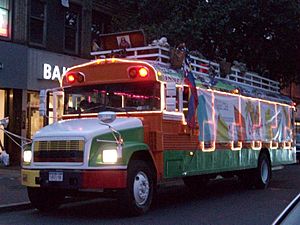
Jackson Heights is among the most diverse neighborhoods in New York City and the nation. Half of the population was foreign born by the 2000s. Jackson Heights is home to large numbers of South Americans (particularly Colombian, Ecuadorean and Argentinian), Indians, Pakistanis, Tibetans, Nepalese, and Bangladeshis. Most businesses are Asian- and Latino-owned, and there are restaurants, bakeries, specialty shops, legal offices, bars, and beauty salons. There is a Little India on 74th Street and a Little Pakistan and Little Bangladesh on 73rd Street. There is also a large concentration of South Americans east of 77th Street, especially a Little Colombia along 37th Avenue.
Jackson Heights was heavily Colombian during the 1980s, but other immigrant groups have settled in the area, notably Mexicans. Many of the displaced Colombians have moved to adjacent areas such as Elmhurst, East Elmhurst, Corona, College Point and Flushing. Queens County still has the largest concentration of Colombians in the United States of any county (roughly 75,000).
Community
The community is home to various houses of worship from a wide array of religions The Community United Methodist Church is on 82nd Street. Saint Joan of Arc Catholic Church is located between 82nd and 83rd Street on 35th Avenue. The Jackson Heights Jewish Center is located on the corner of 77th Street and 37th Avenue. St Mark's Episcopal Church is on 34th Avenue between 81st and 82nd Streets.
The Jackson Heights Garden City Society is a historical society, whose founders include local historians, the Queens Borough Historian and local activists. They created and oversee the Jackson Heights Garden City Trail and publish a walking guidebook to Jackson Heights. They also collect artifacts of the community. Periodically, the Society testifies before the New York City Landmarks Preservation Commission on issues of concern to the community.
In addition, Colombian broadcaster RCN TV has its US-American headquarters in the neighborhood, reflecting the sizable Colombian population in the area.
There is a year-round greenmarket every Sunday morning at Travers Park, as well as various family-oriented spring and summer concerts.
The word game Scrabble was co-invented by former architect Alfred Mosher Butts, who lived in Jackson Heights. There is a street sign at 35th Avenue and 81st Street that is stylized using letters, with their values in Scrabble as a subscript; it was originally erected in 1995 but disappeared in 2008, and a new sign was subsequently put up in 2011.
Parks and recreation
Travers Park is the main local playground. It has a variety of sports, including basketball, tennis, baseball, soccer, and handball.
There is also a park named "One Room Schoolhouse Park", named after the last one-room schoolhouse in Queens. The school was at Astoria Boulevard and 90th Street from 1879 to 1934; it became a playground in 1935 and a garden in 1992.
Prior to expansion, the P.S. 69 school yard offered baseball fields, a stickball field, a handball court and three tennis courts. Con Edison sponsored several summer tennis camps at P.S. 69's school yard from 1982-1992. In 1998, P.S. 69 built an annex to compensate for the booming population of children in Jackson Heights and the public access to the school yard was removed. However, on November 30, 2011, then-Mayor Michael Bloomberg and other city officials opened the 200th "Schoolyard to Playground" at P.S. 69 as a part of the PlaNYC initiative to ensure all New Yorkers live within a 10-minute walk of a park or playground; the program is turning schoolyards into playgrounds in neighborhoods across the city.
In popular culture
- Much of the Alfred Hitchcock film The Wrong Man (1956) takes place within a few blocks of the intersection of Broadway and 74th Street.
- The theme song of the TV show Car 54 Where Are You? (1961–63) has a line that goes: "There's a traffic jam in Harlem that's backed up to Jackson Heights".
- Ingrid Bergman's character Stephanie Dickinson in the movie Cactus Flower (1969) lives in Jackson Heights.
- In Cagney & Lacey (1988), the fictional character Mary Beth Lacey and her family live in an apartment in Jackson Heights.
- In Coming to America (1988), the fictional singer Randy Watson is referred to as "Jackson Heights' own".
- Part of The Usual Suspects (1995) was filmed in Jackson Heights around 34th Avenue and 82nd Street.
- Portions of Random Hearts (1999) were filmed in Jackson Heights on 35th Avenue between 76th and 77th Streets.
- Major portions of the Academy Award-nominated Maria Full of Grace (2004) were filmed on location in Jackson Heights.
- It is also the setting for the TV show Ugly Betty (2006–10), where Betty and her family live.
- Parts of director James Gray's We Own the Night (2007) were filmed between 32nd Avenue and 31st Avenue on 84th Street.
- The eponymous Pakistani drama Jackson Heights is set in this neighborhood and deals with the lives of Pakistanis living in New York City.
- The documentary film In Jackson Heights by Frederick Wiseman explores the diversity of people in the neighborhood.
Economy
US-Bangla Airlines formerly had its U.S. offices in the Bangladesh Plaza building in Jackson Heights.
Education
Jackson Heights generally has a lower ratio of college-educated residents than the rest of the city as of 2018[update]. While 27% of residents age 25 and older have a college education or higher, 30% have less than a high school education and 47% are high school graduates or have some college education. By contrast, 39% of Queens residents and 43% of city residents have a college education or higher. The percentage of Jackson Heights students excelling in math rose from 41% in 2000 to 65% in 2011, and reading achievement rose from 46% to 49% during the same time period.
Jackson Heights's rate of elementary school student absenteeism is less than the rest of New York City. In Jackson Heights, 12% of elementary school students missed twenty or more days per school year, lower than the citywide average of 20%. Additionally, 78% of high school students in Jackson Heights graduate on time, more than the citywide average of 75%.
Schools
New York City Department of Education operates public schools. Schools in Jackson Heights include P.S. 69 Jackson Heights School, P.S. 149 Christa McAuliffe School, P.S. 212, P.S 222 FF Christopher A. Santora School, I.S. 145 Joseph Pulitzer School, P.S. 152, and I.S. 230.
Charter schools include the Pre-K–12 school Renaissance Charter School.
Private schools in the neighborhood include Saint Joan of Arc School (Pre-K3 to 8 grade), Our Lady of Fatima School (Pre-K to 8 grade), Monsignor McClancy Memorial High School, a school which turned co-ed by the end of the 2012 school year, though technically located in East Elmhurst. Garden School, a private, non-profit 501(c)(3) independent school within Jackson Heights, enrolls 300 students from grades Nursery–Grade 12.
82nd Street Academics, a non-profit 501(c)(3) educational institution, is housed at the Community United Methodist Church of Jackson Heights. Since 2003, it has been a community-based Universal Pre-Kindergarten provider under contract with the New York Department of Education.
Library
The Queens Public Library's Jackson Heights branch is located at 35–51 81st Street.
Notable residents
- Rima Fakih, Arab American lady and Miss USA 2010.
- Nadia Ali (born 1980), Arab American singer-songwriter.
- Alene S. Ammond (1933–2019), politician known as "The Terror of Trenton", who served in the New Jersey Senate from the 6th Legislative District from 1974 to 1978.
- Alfred Mosher Butts (1899–1993), invented Scrabble in 1938, and perfected it at Community Methodist Church.
- Chester Carlson (1906–1968), invented Xerox copy machine in his Jackson Heights kitchen.
- Robert P. Casey (1932–2000), Governor of Pennsylvania from 1987 to 1995.
- Lady Catiria, (1959–1999), drag performer.
- Charlie Chaplin (1899–1977), silent film actor
- Thom Christopher (born 1940), longtime actor on One Life to Live.
- Eleanor Clift (born 1940), Newsweek contributing editor and regular panelist on The McLaughlin Group.
- Montgomery Clift (1920–1966), actor, moved to Jackson Heights with his family in 1933 and lived in The Chateau apartments.
- Ray Dalio (born 1949), founder of Bridgewater Associates.
- Alan M. Davis (born 1949), professor and author.
- David Diosa (born 1992), footballer for the Richmond Kickers in USL League One.
- Edward Djerejian (born 1939), diplomat, former United States Ambassador to Syria and Israel and Assistant Secretary of State.
- Albert K. Dawson (1885–1967), photojournalist and cinematographer during the First World War, living at 3564, 89th Street, Jackson Heights, between 1928-1967.
- Kevin Dobson (1943–2020), actor, known for his roles on Kojak and Knots Landing.
- Alfred Eisenstaedt (1898–1995), photographer, lived in Jackson Heights for many years.
- Douglas Fairbanks (1883–1939), actor, screenwriter, director, and producer
- Calvin Fixx (1906—1950), editor at Time magazine.
- Dave Fleming (born 1969), MLB pitcher who spent most of his career with the Seattle Mariners.
- Paul D. Ginsberg (born 1962), President of Roark Capital Group.
- Arthur Googy (born 1961 as Joseph McGuckin), original drummer for the band The Misfits.
- Bobby Hackett (1915–1976), trumpet player who played with Henry Mancini, Benny Goodman, and Louis Armstrong
- Ed Hayes (born 1947), influential lawyer, journalist, and memoirist.
- Helen Kane (1904–1966), singer, known for her baby talk version of I Wanna Be Loved by You and model for Betty Boop.
- Evelyn Fox Keller (born 1936), physicist, author and feminist, who is Professor Emerita of History and Philosophy of Science at the Massachusetts Institute of Technology.
- Richard Kline (born 1944), actor who played Jack's friend Larry on Three's Company.
- John Leguizamo (born 1964), comedian, actor.
- Willy Ley (1906–1969), space writer and theorist.
- Lucy Liu (born 1968), actress.
- Clive Lythgoe (1927–2006), classical pianist.
- John McWhorter (born 1965), linguist and author.
- Victor Moore (1876–1962), actor.
- Billy Murcia (1954–1972), original drummer for the New York Dolls.
- Carroll O'Connor (1924—2001), actor, director, producer
- Colby O'Donis (born 1989), pop and R&B singer-songwriter, guitarist, producer and actor.
- Jakiw Palij (1923–2019), former Nazi concentration camp guard; emigrated to U.S. in 1949, deported in 2018 at age of 95.
- Les Paul (1915–2009), jazz guitarist and guitar innovator.
- Duncan Penwarden (1880–1930), actor.
- Joe Quesada (born 1962), Editor-in-Chief of Marvel Comics.
- Tommy Rettig (1941–1996), actor who appeared on the 1950s Lassie television series.
- Don Rickles (1926–2017), comedian.
- Robert Tripp Ross (1903–1981), Congressman and former Assistant Secretary of Defense from 1954 to 1957.
- Mercedes Ruehl (born 1948), actress.
- Zoe Saldana (born 1978), actress
- Susan Sarandon (born 1946), actress.
- Eddie August Schneider (1911–1940), record-setting early aviator.
- Walter Sear (1930–2010), audio engineer.
- Gene Simmons (born 1949), of the rock group Kiss.
- Howard Stern (born 1954), host of The Howard Stern Show.
- Bruce Sussman (born 1949), songwriter, best known for his work with Barry Manilow.
- Maria Terrone, poet and writer.
- Sada Thompson (1927–2011), award-winning actress.
- Johnny Thunders (1952–1991), of the New York Dolls.
- Waddy Wachtel (born 1947), session guitarist.
- Raees Warsi (born 1963), Urdu poet, writer and TV anchor.
- Helene White (born 1954), federal judge on the United States Court of Appeals for the Sixth Circuit.
Images for kids
See also
 In Spanish: Jackson Heights (Queens) para niños
In Spanish: Jackson Heights (Queens) para niños


